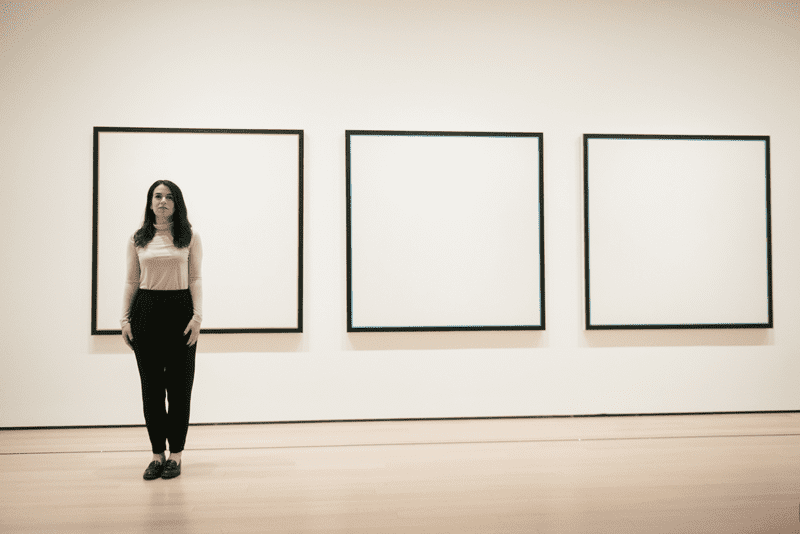Minimalism to the Max

( Ryan Muir )
EPISODE 5: MINIMALISM TO THE MAX
[THEME MUSIC]
I’m Abbi Jacobson and this is A Piece of Work.
In this episode: Minimalism...
[SILENCE]
Just kidding! OK, so today we’re talking about minimalism... the art of not that much?
A stack of boxes, a series of blank canvases, a single fluorescent light. The work that people see in museums and say, “huh, how did this end up here?”
Mark Joshua Epstein: You know when I take my mom to this museum she hates these. She can't handle it. I mean I just saw before a few young women standing in front of this work being like you've got to be kidding me to each other.
I can understand that. Minimalist work seems almost like anti-art. You can’t get a sense of the artist’s hand. And that can lead you to thinking that there’s nothing there, no effort, no beauty.
But that’s just not entirely true. There’s a lot in what seems like very little.
I'm standing in one of the MoMA galleries with Mark Joshua Epstein, a teaching artist here.
Mark Joshua Epstein: Work for The Museum of Modern Art, the Whitney Museum of American Art, the Jewish Museum. And when I’m not doing any of those things, I’m in a studio space in east Williamsburg up five flights of stairs.
And we're looking at what appear to be three blank canvases. They're squares, and each has a thin colored band of paint around the edge--red, green, blue and surrounded by a thicker band of black paint.
The piece is called "Primary Light Group: Red, Green, Blue" and it's by the artist Jo Baer.
I personally love it. I feel like it allows me a space to be calm and think about what’s happening in my life. I found it extremely peaceful. But I also don’t entirely get it.
Abbi: Whenever I go into a museum or art gallery and look at art, I find and I hope this doesn't come off as insulting as an art educator.
Mark Joshua Epstein: Bring it.
Abbi: My thing is like I don't always want to know what the intention was because I kind of am of the mindset like, I was just saying this and sort of discovered it. I'm like well this is like my experience is the thing or else the artists would have written a whole manifesto about the thing.
Mark Joshua Epstein: This is great. Ok I am married to an art historian and the hugest knock down drag out most crazy fights we have are about our experience walking into a museum because he will go right for the wall text and he wants to know what the curator says or what the artist says he wants to know the information before looking at the work.
That’s the biggest fight they have? OK, go on...
Mark Joshua Epstein: I really believe art should be some kind of sensory experience, visual, audio, smell, something and that you have to have a moment of being frustrated, maybe being in the weeds, being in the dark, where you’re just experiencing the work, and I think museum text and museum educators are for people who maybe want a little more concrete information but if someone walked through a show at MoMA and just really enjoyed each art work and kind of thought about maybe how they were made or how the colors made them feel or maybe related it to the socks they were wearing that day and then left. I feel like 100% success.
And that’s kind of what this whole podcast is about. It’s ok to not know exactly what the art means. Or what’s going on historically. Or even the artist’s intention. Your experience with art is exactly that, yours. Again, when I look at this piece by Jo Baer, I feel like it’s giving me a moment some space to think and process and the more my eyes go back and forth between these three paintings the colors engage and ignite my brain.
And it turns out, Baer studied psychology, and worked towards a master’s degree, specifically on perception. So these paintings, each one white with those thin bands of color, they have a funny way of messing with your eyes.
Mark Joshua Epstein: These, you know, look really simple but they weren't really simple to get them really perfect took a lot of effort. And so that's interesting to me. But I think if you can get a group to actually stand in front of this work and spend 30 seconds or a minute just looking. Often people will start to have experiences like they'll realize that the magenta band and the green band and the blue band are the same value and they have the same amount of white in them starts to do things to your eye.
So these pieces are deeper than they look. When you take a little time, as Mark says, the colors start mixing into each other, the white doesn’t feel so white, you even start noticing the floaties in your own eyes. Essentially there’s a lot to look at.
And still, people pass these pieces by, wondering why a blank canvas is in a museum and feeling kind of pissed about it.
Mark Joshua Epstein: And that is a win for Jo Baer, Jo Baer wins if she can make paintings you know 50 60 years ago that are still really pissing people off. I feel like she was on to something. Yeah it's what you as an artist kind of dream of that someone spends enough time in front of something to to have a feeling or a thought even if it's a negative one.
That’s true. You want a reaction, you want to get people to take a second look, even if it’s to say that’s bullshit. If it pushes buttons, it’s doing something right. And as a woman, making art in the 1960s, that was especially important. It was a way to say, I’m here, I’ve got something to say, listen the fuck up.
Mark Joshua Epstein: Things were not easy for women painters, things are not easy for women painters now by the way. But she was like she was kicking ass so she you know basically she gets lumped in with the minimalists, she's showing with Donald Judd and Sol LeWitt and all these other folks. And then Donald Judd and other people start to say actually paintings are not minimalism like a painted object is not minimalism. And she writes a letter to Artforum that's like you're out of your motherfucking mind. You know, she’s like, I am making minimalism. So she was just like she was on it. Like, her, Lee Krasner. They are these women who just were not taking any bullshit.
Abbi: Hello
Jo Baer: Hello is this Abbi?
Abbi: Yes, is this Jo?
Jo Baer: Yes, this is Jo.
Abbi: Hi, what a pleasure, this is so exciting for me.
Jo Baer called me from where she lives in Amsterdam. She left the US forty years ago and has been living in Europe ever since.
In the 1960s, Jo stood out among the so-called Minimalists because she was a rare breed: a painter.
Jo Baer: I’ve never been a minimalist, I was considered one. But I got into a war with Judd and Morris and things like that. I wrote an article, since the sculptors were leaving us painters out. I attacked them back in Artforum. When I decided I had had enough of “painting is dead” and things of that sort I just took it upon at first I tried to write some letters to some of these people which they never answered. And then I decided to write them in public. And I took Judd apart and I took Flavin apart...
That being said…
Jo Baer: I don’t want to attack other artists.
Jo Baer is in her 80s now and she’s still busy. She’s making art and she’s writing a book.
Abbi: You were kind of like this bad ass, still.
Jo Baer: Listen, I wasn't bad ass I just said no when I didn't want to do something. That's very rare in the art world…I had a reputation for saying no if I didn't like it.
Abbi: Rightfully so. You know, as a woman in comedy, coming up, comedy has been like kind of throughout history more of a boys club or something. Or people like to talk about it being a boys club and people like to talk about the art world being a boys club as well.
Jo Baer: Yes it was.
Abbi: Can you speak a little bit about it to that?
Jo Baer: I didn't feel very much about it because I was first of all trained through masters level as a scientist. So I came to a painting very late, 28 29, and sort of looked around and decided what I wanted to do. My mother was a commercial artist so I'm second generation artist and had been avoiding competing with her. And the first shows I was in, which were more or less by accident, but were in the the Guggenheim, the paintings were bought off the wall.
Abbi: Wow.
Jo Baer: So, I was included in all the shows I should have been included in.
Abbi: Yeah.
Jo Baer: But I was the only woman in that group. So why would I have a problem.
Abbi: Right.
Jo Baer: In fact, the feminist called me a female man because I was successful. You know later on I became a role model and then it was all OK but that waited till the year 2000 so I was never part of the feminist things. My work was different. My work was neither female nor male it was both and that doesn't happen very much.
But she was still a woman operating in a man's world.
Jo Baer: I have had paintings returned to me twice. That was at the very beginning when they learned that Jo wasn't a male name, that it was a woman. The first time it happened, the guy lived in Arizona in a bomb shelter with his mother.
Abbi: OK. That makes sense. Yeah that sounds about right.
Jo Baer: The second time was somebody in Canada. OK?
Abbi: Oh my goodness.
Jo Baer: It was within the same year or two. And I think I was a great success in Germany. My German dealers misspelled my name. They spelled J-o-e. So I did very well in Germany.
Abbi: That is so interesting the fact that people like that one would assume that Jo is a man's name and when they learn that you're a woman they give the painting back. Like how does that change the painting?
Jo Baer: It doesn't. I sold it to somebody else. Well, how does it change my work you mean.
Abbi: Yeah. It doesn't change your work at all.
Jo Baer: No my work is always my work. Yeah that's why it's genuine and good and lasted this long.
Yes! It is so inspiring to hear an artist, particularly a woman, talking about how good her work is with such confidence and no apology. You have to believe your shit is good or else why are you making it? If you don’t think that how will anyone else. And Jo Baer after 80 years still crushing it. Her work is still her work. It’s genuine and good and that’s why it’s lasted so long.
Next up, ways to open your space…and your mind.
This is A Piece of Work.
<<<<<<MIDROLL>>>>>>>
So I left MoMA headed downtown to 101 Spring Street, the former home of the artist, Donald Judd, now the Judd Foundation. He’s the artist most closely associated with what people call Minimalism.
We were here in the last episode, about Light.
Judd lived here with his family and this place is absolutely incredible. Five sun-filled floors. There’s huge windows and all around you and on every floor, work by Donald Judd, Dan Flavin and other artists from the 60s and 70s like John Chamberlain and Claes Oldenburg.
It’s a museum, but it’s also a home, it’s a relic and it’s fucking mind-blowing.
Abbi: The thing that I feel when I come in here and just like ... It makes me feel different than when you go into a museum because it is like curating your space. It makes me feel like I want to curate my space to be just a little more ...
Flavin Judd: Well, you should.
That’s Flavin Judd, the son of Donald Judd. I know it gets a little confusing because Don’s friend Dan Flavin was also a famous artist … which is why he named his son after him.
So right now I’m talking with Flavin Judd. And he’s showing me around and telling me about the work in this space. It’s all very pristine, elegant. Think perfect plywood tables with matching chairs, galvanized steel frames and stacked iron boxes.
But do not call it “minimalist” -- Donald Judd hated that term.
Flavin Judd: The term minimalism was invented by the critics who didn't like the work. So, using ...
Abbi: I see.
Flavin Judd: The term minimalism to describe Don or Dan's work…
That’s what Flavin calls his Dad: Don.
Flavin Judd: ...is kind of like describing every Italian restaurant as a pizzeria and then being upset when you go to a really nice restaurant and they don't have pizza. It's not good for the work and it's actually bad for your understanding and your possibility of understanding the work because you've already shut down what it could be.
Abbi: Right.
Flavin Judd: And it's a reduction of what the art can be and what it can mean. And art should be open.
His dad ultimately decided he needed even more space. So he went out to the middle of Texas, to a small town called Marfa. And he bought some land there to make his work, and to showcase other artists’ work too. It’s gotta be the largest studio any artist has ever had. It’s huge… 400 acres.
His place here in the city is huge too, by New York City standards--15-thousand square feet. Just ask a realtor what that means and they’ll tell you that it’s uh huge. And it’s got furniture carefully designed by Judd: a bed, a table, chairs, each specifically placed in the space.
Flavin Judd: For him, it was a big consideration where things went and how they worked in the space because that's how you lived with it. It was not just arbitrary. It was not just a throw away consideration. It was actually a big preoccupation.
Abbi: A big part of it.
Flavin Judd: Especially for the art. The art was very much influenced by its context.
Space. And light. The whole environment. That’s the thing with these artists, whether you call them Minimalists, or something else.
People come here expecting to walk around and look at some art … but it’s not just the pieces, it’s the entire space around the work.
Flavin Judd: If you see one of Dan’s pieces in a big museum stuck in a corner, it's really not going to have an effect at all because it will kind of be lost. The true is same for a lot of artwork. Museums are not the best place for them. So, the artwork gains an effect when it's placed correctly. For instance, that's why Don started his own museum in Marfa and why he wanted his own spaces preserved because he put so much care into where everything went. If you see an exhibition that is correctly done, the effect is really great and is really evident and there's no mistaking that it's art because it is spectacular.
So maybe it’s not about knowing or talking about what’s going on in this work. It’s more about observing and seeing and letting it all sink in. Minimalist work encourages you to look beyond the pieces themselves and maybe have a moment of reflection.
Minimalism is definitely not nothing--it’s everything.
[MUSIC]
And that’s A Piece of Work.
Thanks to Mark Joshua Epstein, Jo Baer, and Flavin Judd.
The show is a co-production of WNYC Studios and MoMA.
Abbi: Yeah, that felt good. Maybe I should drink the night before all the time. Too late!
###






